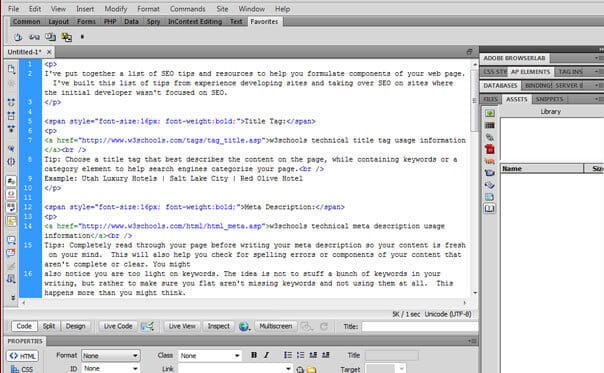I’ve put together a list of SEO tips and resources to help you formulate components of your website. I’ve built this list of tips from experience developing sites and taking over SEO on sites where the initial developer wasn’t focused on SEO.
Title Tag:
Tip: Choose a title tag that best describes the content on the page, while containing keywords or a category element to help search engines categorize your page.
Example: Utah Luxury Hotels | Salt Lake City | Red Olive Hotel
w3schools technical title tag usage information
Meta Description:
Tips: Completely read through your page before writing the meta description so your content is fresh on your mind. This will also help you check for spelling errors or parts of your writing that may not be clear. You might also notice you are too light on keywords. The idea is not to stuff a bunch of keywords in your writing, but rather, to make sure you flat aren’t missing keywords and not using them at all. This happens more than you might think.
Go read what other companies in your industry are writing in their meta descriptions. See what you like or don’t like about their descriptions, and then use this information to help guide the writing for your meta description. Think about what makes your service or product different from other companies and incorporate this into your meta description. Lastly make sure your meta description is on-topic and uses related words or some of the same words that were used in your title tag and page content. Congruency is good here.
w3schools technical meta description usage information
H1 Tag:
Tip: Reserve the use of ‘h’ tags for your page headings. Don’t use h1 tags for links, buttons, or other elements that are not headings. There is tendency for developers to use h1 for various items across the page while trying to apply font size styles.
w3schools technical h tag usage information
P Tag:
Tip: I prefer to break up content using ‘p’ tags and not a bunch of ‘br’ tags. But go with your personal preference.
w3schools technical p tag usage information
A Tag:
Tip: Links and the anchor text for your link. Put ‘a’ tags around words that help the user quickly get an idea of what type of page or content that link points to. In other words, put ‘a’ tags around keywords or category phrases. It is also helpful to link call-to-action phrases. Be careful not to have the same word linked twice on a page and then send the user to two different places. This is confusing and probably not helpful for a search engine or user.
w3schools technical a tag usage information
URLs:
Tip: Try to create urls that are organized, contain categories or keywords. Don’t create urls that are too simple or way too complex and strung out. Using overly simple urls, such as product.html, can really hurt your site’s potential. Creating overly complex urls such as /ti55-red-running-shoes-12345.html aren’t so great either. While this is better than the first example, because it includes information about the page, it is still kind of hard for the user to remember. Something like /shoes/red-running-shoes is probably a better start.
Navigation or Nav:
Tip: Don’t be overly generic like this: Home, Products, About, Contact. A user should be able to figure out what type of company you are just by reading the text from your navigation.
About the Author:I am in my 3rd year here at Red Olive Design (12/2011). I started out developing sites and helping with SEO. While I am now solely focused on SEO services, I still love a little coding. I graduated from the University of Utah with a degree in Psychology, and go figure, I didn’t need it for my career. If you are interested in learning SEO I recommend you study websites that currently rank well, view their source code, view their link profile, study how they structure their urls, content, and navigation. Spend less time trying to discover the latest gimmick or trick.
Follow me on twitter at @redoliveryan
